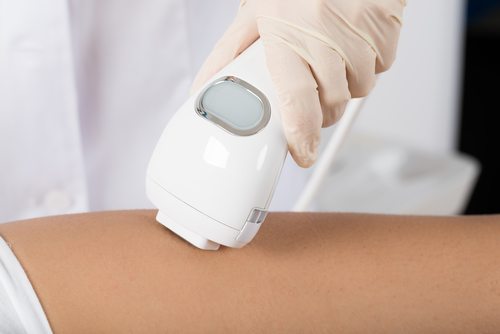Although seborrheic keratoses (SKs) are harmless and quite common, they may be aesthetically or physically bothersome. They begin as small, rough bumps, typically forming on middle-aged and older adults. Over time, however, they can thicken and spread, forming a warty surface and darkening in color to tan, brown, or even black. People who develop seborrheic keratoses often have more than one, and the bumps can appear almost anywhere on the skin. Their waxy, “pasted-on” look is unique when compared with other skin growths like warts, moles, and actinic keratoses. Although seborrheic keratoses are benign (i.e., non-cancerous), they can be frustrating and troublesome just the same. To learn more about seborrheic keratosis treatment, review the advice and information below.
Seborrheic Keratosis Treatment
How do you pronounce seborrheic keratosis?
With such an unusual spelling, we aren’t surprised you asked! The term is pronounced seb-o-REE-ik ket-uh-TOE-sis. It is a combination of the words seborrhea (a skin disorder that causes scaly, flaky, and itchy skin) and keratinocyte (the part of the epidermis that produces keratin) as well as the suffix -osis, which means “abnormal.”
Are seborrheic keratoses dangerous?
No. As we mentioned above, seborrheic keratoses are harmless. However, observe the lesion regularly and if you notice any changes, alert your physician. In addition, if the lesion becomes itchy or irritated by clothing or jewelry, there is a slight risk of infection due to picking at the skin. In this case, you may wish to have the lesion removed to prevent further affliction. And of course, you may also decide to remove a seborrheic keratosis for aesthetic reasons.
How are seborrheic keratoses removed?
- Laser Treatment: During a laser treatment, an intense beam of light will be directed at the lesion. The laser will cleanly and hygienically burn and destroy the skin growth, sterilizing and sealing the tissue as it cuts. The process is quick, but the wound may be tender afterward.
- Shave Excision: Because seborrheic keratoses are raised above the surrounding skin, with a minimal dermal component, they can be excised through shaving. The lesion will be horizontally sliced off using a sharp blade for a clean cut. Like laser treatments, shave excision is quick and typically produces positive cosmetic results.
- Electrosurgery: An electrosurgical device like the Ellmann Radio Frequency (RF) machine offers added precision and control. It easily and evenly removes the lesion with little to no scarring. As you might have guessed, it is also a very fast treatment, requiring only one visit.
Thankfully, when properly performed, seborrheic keratosis treatment will not cause much visible scarring. In some cases, however, it will leave the skin lighter than before.
If you would like to pursue seborrheic keratosis treatment, contact DermaHealth Laser & Skin Care Clinic if you live in or near Springfield, Missouri. Our friendly, experienced, and knowledgeable skin care technicians can remove the lesion using a laser, shave excision, or electrosurgery with Ellman RF. Epionce Lytic and MelanoLyte treatments will also be beneficial. To get started, schedule a free consultation online or call 417-447-7777. We can further explain your treatment options, provide a personalized evaluation, and answer any questions you may have regarding the treatment of seborrheic keratoses. We look forward to hearing from you!







